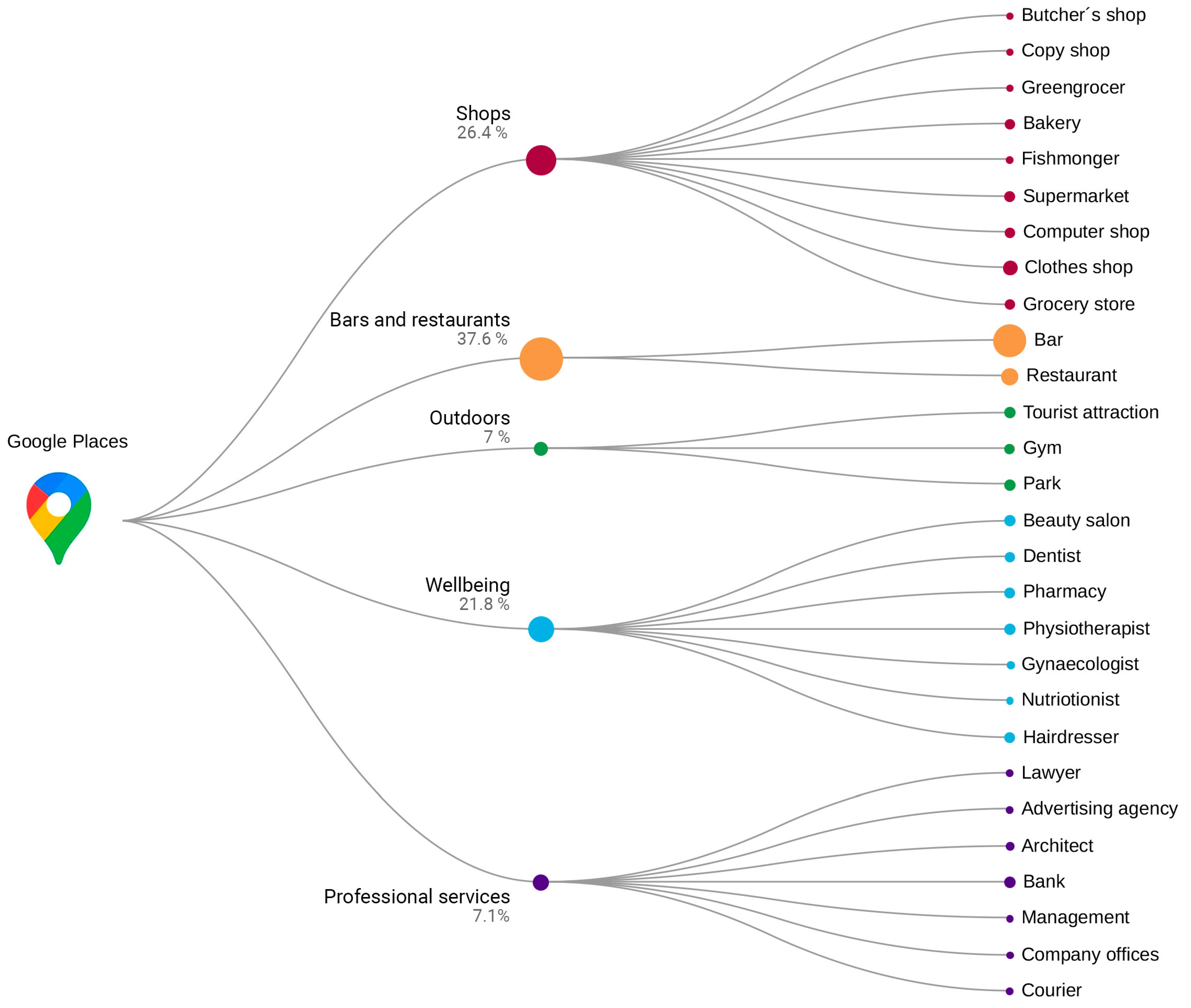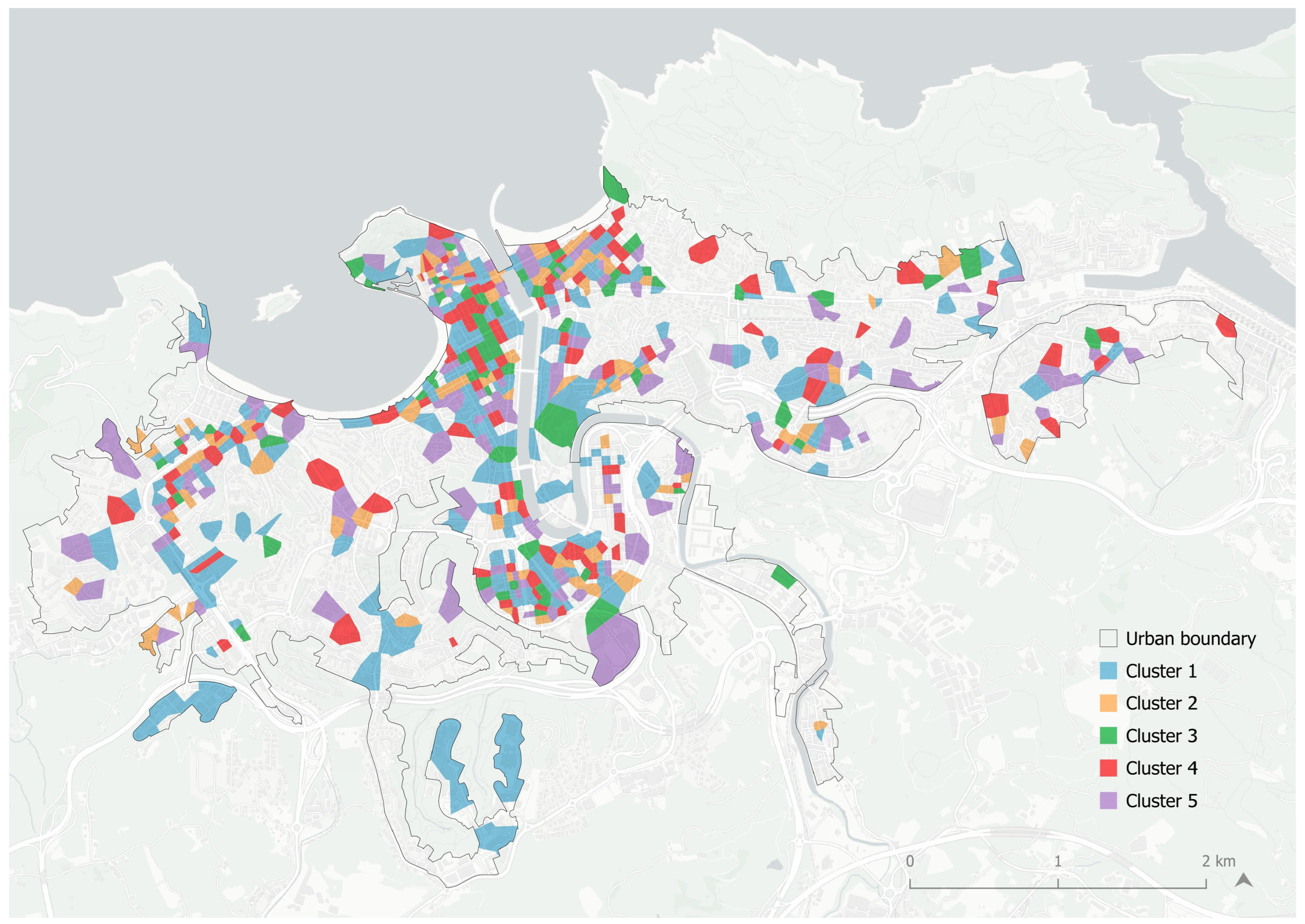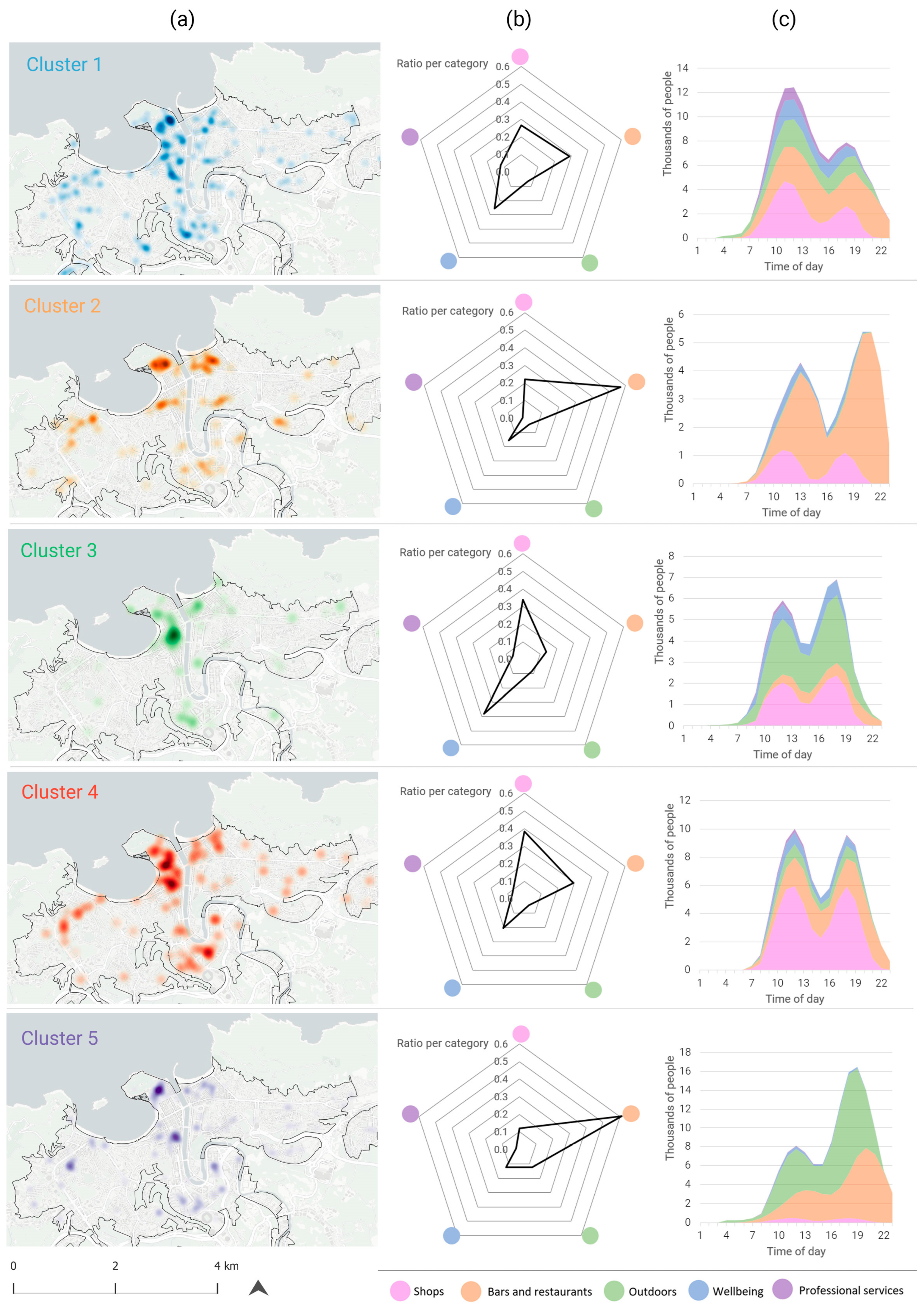Revealing Spatiotemporal Urban Activity Patterns: A Machine Learning Study Using Google Popular Times
Abstract
1. Introduction
1.1. General Overview
1.2. Literature Review
2. Materials and Methods
2.1. Study Area
2.2. Methodology
- (a)
- Collection and Processing of Cartographic and GPT Data
- -
- Popular times: Hourly average occupancy as a percentage relative to the peak occupancy.
- -
- Category: The main category declared by the owner on Google My Business.
- -
- Geolocation: Geographical coordinates.
- -
- Address: Street name and door number.
- (b)
- Unit of Analysis: the Morphological Grid
- (c)
- Weighted Occupancy Calculation
- P = capacity (maximum number of people);
- A = floor area (m2);
- δ = density (m2/person);
- j = cell;
- i = POIs;
- c = category.
| Intended Use According to CTE | Occupation (m2/Person) | POI Category |
|---|---|---|
| Administrative | 10 | Lawyer |
| Advertising agency | ||
| Architect | ||
| Bank | ||
| Management | ||
| Company offices | ||
| Commercial | 2 | Butcher’s shop |
| Beauty salon | ||
| Clothes shop | ||
| Grocery | ||
| Bakery | ||
| Hairdresser | ||
| Fishmongers | ||
| Pharmacy | ||
| Greengrocer’s | ||
| 3 | Copy shop | |
| Courier service | ||
| Computer shop | ||
| 5 | Supermarket | |
| Public | 1 | Bars |
| 0.5 | Pub | |
| Dance club | ||
| Disco club | ||
| 1.5 | Restaurant | |
| 5 | Gym | |
| 10 | Square | |
| Tourist attraction | ||
| 25 1 | Park | |
| Hospital | 10 | Dentist |
| Nutritionist | ||
| 15 | Gynaecologist | |
| Physiotherapist |
- O = weighted occupancy rate (%);
- P = capacity (number of people);
- GPT = relative occupancy data of Google Popular Times (%);
- j = cell;
- i = POIs;
- t = time interval (h).
- (d)
- Urban Cell Time Series Clustering and Occupancy Pattern Definition
- -
- The elbow method, which identifies the point at which the variance within clusters stabilizes. This is based on the average distance of each centroid to all observations in its cluster.
- -
- The silhouette score, which is maximized to identify the optimal number of clusters for the dataset. This score measures the distance between clusters and assesses how closely each observation in a cluster is to the nearest neighboring cluster.
- (e)
- Spatial Analysis of Spatiotemporal Clusters
3. Results
3.1. Spatial Distribution and Temporal Occupancy Patterns of POIs Categories
3.2. Description of Spatiotemporal Clusters
3.2.1. Temporal Analysis
- -
- Cluster 1 (C1)
- -
- Cluster 2 (C2)
- -
- Cluster 3 (C3)
- -
- Cluster 4 (C4)
- -
- Cluster 5 (C5)
3.2.2. Spatial Analysis
4. Discussion
5. Conclusions
Author Contributions
Funding
Data Availability Statement
Acknowledgments
Conflicts of Interest
References
- Hägerstrand, T. What about people in Regional Science? Pap. Reg. Sci. Assoc. 1970, 24, 6–21. [Google Scholar] [CrossRef]
- Couclelis, H. Space, time, geography. In Geographical Information Systems, 1st ed.; Longley, P.A., Goodchild, M.F., Maguire, D.J., Rhind, D.W., Eds.; John Wiley and Sons: New York, NY, USA, 1999; Volume 1, pp. 29–38. [Google Scholar]
- Rapoport, A. Human Aspects of Urban Form; Pergamon Press: Oxford, UK, 1977. [Google Scholar] [CrossRef]
- Hillier, B.; Penn, A.; Hanson, J.; Grajewski, T.; Xu, J. Natural movement: Or, configuration and attraction in urban pedestrian movement. Environ. Plan. B Plan. Des. 1993, 20, 29–66. [Google Scholar] [CrossRef]
- Moore-Cherry, N.; Bonnin, C. Playing with time in Moore Street, Dublin: Urban redevelopment, temporal politics and the governance of space-time. Urban Geogr. 2020, 41, 1198–1217. [Google Scholar] [CrossRef]
- Goodchild, M.F.; Janelle, D.G. The city around the clock: Space-time patterns of urban ecological structure (Halifax, Canada). Environ. Plan. A 1984, 16, 807–820. [Google Scholar] [CrossRef]
- Janelle, D.G.; Klinkenberg, B.; Goodchild, M.F. The temporal ordering of urban space and daily activity patterns for population role groups. Geogr. Syst. 1998, 5, 117–137. [Google Scholar]
- Anderson, J. Space-Time Budgets and Activity Studies in Urban Geography and Planning. Environ. Plan. A Econ. Space 1971, 3, 353–368. [Google Scholar] [CrossRef]
- Goodchild, M.F.; Klinkenberg, B.; Janelle, D.G. A Factorial Model of Aggregate Spatio-Temporal Behavior: Application to the Diurnal Cycle. Geogr. Anal. 1993, 25, 277–294. [Google Scholar] [CrossRef]
- Brail, R.K.; Chapin, F.S. Activity patterns of urban residents. Environ. Behav. 1973, 5, 163–190. [Google Scholar] [CrossRef]
- Grese, R.E. A Sense of Place, a Sense of Time. Landsc. J. 1995, 14, 226–227. [Google Scholar] [CrossRef]
- Meentemeyer, V. Geographical perspectives of space, time, and scale. Landsc. Ecol. 1989, 3, 163–173. [Google Scholar] [CrossRef]
- Lískovec, R.; Lichter, M.; Mulíček, O. Chronotopes of urban centralities: Looking for prominent urban times and places. Geogr. J. 2022, 188, 166–176. [Google Scholar] [CrossRef]
- Nevejan, C.; Cunningham, S.; Sefkatli, P. City Rhythm Logbook of an Exploration; Delft University of Technology: Delft, The Netherlands, 2018. [Google Scholar]
- Chen, L.; Zhao, L.; Xiao, Y.; Lu, Y. Investigating the spatiotemporal pattern between the built environment and urban vibrancy using big data in Shenzhen, China. Comput. Environ. Urban Syst. 2022, 95, 101827. [Google Scholar] [CrossRef]
- Wunderlich, F.M. Place-Temporality and Urban Place-Rhythms in Urban Analysis and Design: An Aesthetic Akin to Music. J. Urban Des. 2013, 18, 383–408. [Google Scholar] [CrossRef]
- Row, A.T.; Jacobs, J. The Death and Life of Great American Cities. Yale Law J. 1962, 71, 1597–1602. [Google Scholar] [CrossRef]
- Pafka, E. Places as Intersecting Flows: Mapping Urban Morphologies, Functional Constellations and Pedestrian Rhythms. In Proceedings of the Space and Place, 4th Global Conference, Oxford, UK, 9–12 September 2013. [Google Scholar]
- Mulíček, O.; Osman, R.; Seidenglanz, D. Urban rhythms: A chronotopic approach to urban timespace. Time Soc. 2015, 24, 304–325. [Google Scholar] [CrossRef]
- Osman, R.; Mulíček, O. Urban chronopolis: Ensemble of rhythmized dislocated places. Geoforum 2017, 85, 46–57. [Google Scholar] [CrossRef]
- Tan, W.; Klaasen, I. 24/7 Environments: A Theoretical and Empirical Exploration from an Urban Planners Perspective. In Proceedings of the European Urban Research Association (EURA): 10th Anniversary Conference, Glasglow, Scotland, 12–14 September 2007. [Google Scholar]
- Bromley, R.D.F.; Tallon, A.R.; Thomas, C.J. Disaggregating the space-time layers of city-centre activities and their users. Environ. Plan. A 2003, 35, 1381–1851. [Google Scholar] [CrossRef]
- Palmer, J.R.B. Activity-Space Segregation: Understanding Social Divisions in Space and Time; Princeton University: Princeton, NJ, USA, 2013. [Google Scholar]
- Roberts, M.; Eldridge, A. Quieter, safer, cheaper: Planning for a more inclusive evening and night-time economy. Plan. Pract. Res. 2007, 22, 253–266. [Google Scholar] [CrossRef]
- Van Liempt, I.; van Aalst, I.; Schwanen, T. Introduction: Geographies of the urban night. Urban Stud. 2015, 52, 407–421. [Google Scholar] [CrossRef]
- Roberts, M.; Turner, C. Conflicts of liveability in the 24-hour city: Learning from 48 hours in the life of London’s Soho. J. Urban Des. 2005, 10, 171–193. [Google Scholar] [CrossRef]
- Ghafouri, A.; Weber, C. Multifunctional Urban Spaces a Solution to Increase the Quality of Urban Life in Dense Cities. Manzar 2020, 12, 34–45. [Google Scholar] [CrossRef]
- Jones, M.; Pebley, A.R. Redefining Neighborhoods Using Common Destinations: Social Characteristics of Activity Spaces and Home Census Tracts Compared. Demography 2014, 51, 727–752. [Google Scholar] [CrossRef]
- Mehta, V. Lively streets: Determining environmental characteristics to support social behavior. J. Plan. Educ. Res. 2007, 27, 165–187. [Google Scholar] [CrossRef]
- Taylor, R.B. Defining Neighborhoods in Space and Time. Cityscape 2012, 14, 225–230. [Google Scholar]
- Shirazi, M.R. Mapping neighbourhood outdoor activities: Space, time, gender and age. J. Urban Des. 2019, 24, 715–737. [Google Scholar] [CrossRef]
- Smith, R.J.; Hetherington, K. Urban rhythms: Mobilities, Space and Interaction in the contemporary city. Sociol. Rev. 2013, 61 (Suppl. 1), 4–16. [Google Scholar] [CrossRef]
- Diepen, A.M.L.; Musterd, S. Lifestyles and the city: Connecting daily life to urbanity. J. Hous. Built Environ. 2009, 24, 331–345. [Google Scholar] [CrossRef]
- Raman, S. Designing a liveable compact city physical forms of city and social life in urban neighbourhoods. Built Environ. 2010, 36, 63–80. [Google Scholar] [CrossRef]
- Boeing, G. Measuring the complexity of urban form and design. Urban Des. Int. 2018, 23, 281–292. [Google Scholar] [CrossRef]
- Batty, M.; Besussi, E.; Maat, K.; Harts, J.J. Representing multifunctional cities: Density and diversity in space and time. Built Environ. 2004, 30, 324–337. [Google Scholar] [CrossRef]
- Kwan, M.P. Time, information technologies, and the geographies of everyday life. Urban Geogr. 2002, 23, 471–482. [Google Scholar] [CrossRef]
- Li, S.; Dragicevic, S.; Castro, F.A.; Sester, M.; Winter, S.; Coltekin, A.; Pettit, C.; Jiang, B.; Haworth, J.; Stein, A.; et al. Geospatial big data handling theory and methods: A review and research challenges. ISPRS J. Photogramm. Remote Sens. 2016, 115, 119–133. [Google Scholar] [CrossRef]
- Toole, J.L.; Colak, S.; Sturt, B.; Alexander, L.P.; Evsukoff, A.; González, M.C. The path most traveled: Travel demand estimation using big data resources. Transp. Res. Part C Emerg. Technol. 2015, 58, 162–177. [Google Scholar] [CrossRef]
- Kitchin, R. The real-time city? Big data and smart urbanism. GeoJournal 2014, 79, 1–14. [Google Scholar] [CrossRef]
- Puebla, J.G. Big Data y nuevas geografías: La huella digital de las actividades humanas. Doc. Anal. Geogr. 2018, 64, 195–217. [Google Scholar]
- Gao, S.; Liu, Y.; Wang, Y.; Ma, X. Discovering spatial interaction communities from mobile phone data. Trans. GIS 2013, 17, 463–481. [Google Scholar] [CrossRef]
- Liu, Z.; Ma, T.; Du, Y.; Pei, T.; Yi, J.; Peng, H. Mapping hourly dynamics of urban population using trajectories reconstructed from mobile phone records. Trans. GIS 2018, 22, 494–513. [Google Scholar] [CrossRef]
- Yang, X.; Fang, Z.; Xu, Y.; Shaw, S.-L.; Zhao, Z.; Yin, L.; Zhang, T.; Lin, Y. Understanding spatiotemporal patterns of human convergence and divergence using mobile phone location data. ISPRS Int. J. Geoinf. 2016, 5, 177. [Google Scholar] [CrossRef]
- Gao, S. Spatio-Temporal Analytics for Exploring Human Mobility Patterns and Urban Dynamics in the Mobile Age. Spat. Cogn. Comput. 2015, 15, 86–114. [Google Scholar] [CrossRef]
- Chen, Y.; Liu, X.; Li, X.; Liu, X.; Yao, Y.; Xu, X.; Pei, F. Delineating urban functional areas with building-level social media data: A dynamic time warping (DTW) distance based k-medoids method. Landsc Urban Plan. 2017, 160, 48–60. [Google Scholar] [CrossRef]
- Hu, Y.; Gao, S.; Janowicz, K.; Yu, B.; Li, W.; Prasad, S. Extracting and understanding urban areas of interest using geotagged photos. Comput. Environ. Urban Syst. 2015, 54, 240–254. [Google Scholar] [CrossRef]
- Wang, Y.; Wang, T.; Tsou, M.H.; Li, H.; Jiang, W.; Guo, F. Mapping dynamic urban land use patterns with crowdsourced geo-tagged social media (Sina-Weibo) and commercial points of interest collections in Beijing, China. Sustainability 2016, 8, 1202. [Google Scholar] [CrossRef]
- Steiger, E.; Resch, B.; Zipf, A. Exploration of spatiotemporal and semantic clusters of Twitter data using unsupervised neural networks. Int. J. Geogr. Inf. Sci. 2016, 30, 1694–1716. [Google Scholar] [CrossRef]
- Ma, X.; Liu, C.; Wen, H.; Wang, Y.; Wu, Y.J. Understanding commuting patterns using transit smart card data. J. Transp. Geogr. 2017, 58, 135–145. [Google Scholar] [CrossRef]
- Gan, Z.; Yang, M.; Feng, T.; Timmermans, H. Understanding urban mobility patterns from a spatiotemporal perspective: Daily ridership profiles of metro stations. Transportation 2020, 47, 315–336. [Google Scholar] [CrossRef]
- Froehlich, J.; Neumann, J.; Oliver, N. Sensing and predicting the pulse of the city through shared bicycling. In Proceedings of the IJCAI International Joint Conference on Artificial Intelligence, Pasadena, CA, USA, 11–17 July 2009. [Google Scholar]
- Ma, X.; Cao, R.; Jin, Y. Spatiotemporal clustering analysis of bicycle sharing system with data mining approach. Information 2019, 10, 163. [Google Scholar] [CrossRef]
- Zeng, P.; Wei, M.; Liu, X. Investigating the spatiotemporal dynamics of urban vitality using bicycle-sharing data. Sustainability 2020, 12, 1714. [Google Scholar] [CrossRef]
- Rempe, F.; Huber, G.; Bogenberger, K. Spatio-Temporal Congestion Patterns in Urban Traffic Networks. Transp. Res. Procedia 2016, 15, 513–524. [Google Scholar] [CrossRef]
- Zhang, K.; Sun, D.J.; Shen, S.; Zhu, Y. Analyzing spatiotemporal congestion pattern on urban roads based on taxi GPS data. J. Transp. Land Use 2017, 10. [Google Scholar] [CrossRef]
- Mao, F.; Ji, M.; Liu, T. Mining spatiotemporal patterns of urban dwellers from taxi trajectory data. Front. Earth Sci. 2016, 10, 205–221. [Google Scholar] [CrossRef]
- Carpio-Pinedo, J.; Romanillos, G.; Aparicio, D.; Martín-Caro, M.S.H.; García-Palomares, J.C.; Gutiérrez, J. Towards a new urban geography of expenditure: Using bank card transactions data to analyze multi-sector spatiotemporal distributions. Cities 2022, 131, 103894. [Google Scholar] [CrossRef]
- Liu, S.; Zhang, L.; Long, Y. Urban vitality area identification and pattern analysis from the perspective of time and space fusion. Sustainability 2019, 11, 4032. [Google Scholar] [CrossRef]
- Xia, Z.; Li, H.; Chen, Y.; Liao, W. Identify and delimitate urban hotspot areas using a network-based spatiotemporal field clustering method. ISPRS Int. J. Geoinf. 2019, 8, 344. [Google Scholar] [CrossRef]
- Yao, X.; Zhu, D.; Gao, Y.; Wu, L.; Zhang, P.; Liu, Y. A Stepwise Spatio-Temporal Flow Clustering Method for Discovering Mobility Trends; IEEE Access: Piscataway, NJ, USA, 2018; Volume 6. [Google Scholar] [CrossRef]
- Santiago-Iglesias, E.; Carpio-Pinedo, J.; Sun, W.; García-Palomares, J.C. Frozen city: Analysing the disruption and resilience of urban activities during a heavy snowfall event using Google Popular Times. Urban Clim. 2023, 51, 101644. [Google Scholar] [CrossRef]
- Calafiore, A.; Palmer, G.; Comber, S.; Arribas-Bel, D.; Singleton, A. A geographic data science framework for the functional and contextual analysis of human dynamics within global cities. Comput. Environ. Urban Syst. 2021, 85, 101539. [Google Scholar] [CrossRef]
- Eustat. Tablas Estadísticas: Edificios de la C.A. de Euskadi por Ámbitos Territoriales, Según Tipo de Edificio. Instituto Vasco de Estadística. 2021. Available online: https://www.eustat.eus/municipal/datos_estadisticos/donostia_san_sebastian_c.html (accessed on 30 July 2024).
- Fernandez-Crehuet, J.M.; Gimenez-Nadal, J.I.; Reyes Recio, L.E. The National Work–Life Balance Index©: The European Case. Soc. Indic. Res. 2016, 128, 341–359. [Google Scholar] [CrossRef]
- Eustat. Proporción de Personas Entre 16 y 74 Años Que Han Usado el Móvil en los Últimos Tres Meses. Published online 2022. Available online: https://www.eustat.eus/indicadores/temaseleccionado_5.b.1.1/ods2.html (accessed on 30 July 2024).
- Eustat. Panorama de la Sociedad de la Información 2022 [Nota de Prensa]. Instituto Vasco de Estadística. 2022. Available online: https://www.eustat.eus/elementos/el-565-de-los-internautas-participa-en-redes-sociales-y-el-552-de-las-empresas-las-usa-para-fines-empresariales-en-la-ca-de-euskadi-en-2022/not0020532_c.html (accessed on 30 July 2024).
- Eustat. Establecimientos y Personas Empleadas en Municipios de Más de 10.000 Habitantes Según Rama de Actividad (A10). Instituto Vasco de Estadística. 2023. Available online: https://www.eustat.eus/elementos/ele0005800/establecimientos-y-personas-empleadas-en-municipios-de-mas-de-10000-habitantes-segun-rama-de-actividad-a10/tbl0005834_c.html (accessed on 30 July 2024).
- D’Zmura, M. Behind the Scenes: Popular Times and Live Busyness Information. Available online: https://blog.google/products/maps/maps101-popular-times-and-live-busyness-information/ (accessed on 3 March 2025).
- Drobník, J. Google Maps Scraper. 2019. Available online: https://github.com/josiahakinloye/store-crawler-google-places (accessed on 4 May 2022).
- Diputación de Gipuzkoa. Catastro de Gipuzkoa. Diputación de Gipuzkoa. 2025. Available online: https://www.gipuzkoairekia.eus/es/datu-irekien-katalogoa/-/openDataSearcher/detail/detailView/f249fd69-9765-4850-9bf8-c3ad457d848e (accessed on 24 January 2025).
- Dunham, H.W. The Image of the City Kevin Lynch. Soc. Probl. 1960, 8, 280–281. [Google Scholar] [CrossRef]
- Paparrizos, J.; Gravano, L. K-Shape: Efficient and Accurate Clustering of Time Series. SIGMOD Rec. 2016, 45, 69–76. [Google Scholar] [CrossRef]
- Zhu, Y.; Diao, M. Understanding the spatiotemporal patterns of public bicycle usage: A case study of Hangzhou, China. Int. J. Sustain. Transp. 2020, 14, 163–176. [Google Scholar] [CrossRef]
- Santiago-Iglesias, E.; Romanillos, G.; Carpio-Pinedo, J.; Sun, W.; García-Palomares, J.C. Recovering urban nightlife: COVID-19 insights from Google Places activity trends in Madrid. J. Maps 2024, 20, 2371927. [Google Scholar] [CrossRef]
- Happle, G.; Fonseca, J.A.; Schlueter, A. Context-specific urban occupancy modeling using location-based services data. Build Environ. 2020, 175, 106803. [Google Scholar] [CrossRef]
- Bernabeu-Bautista, Á.; Serrano-Estrada, L.; Perez-Sanchez, V.R.; Martí, P. The geography of social media data in urban areas: Representativeness and complementarity. ISPRS Int. J. Geoinf. 2021, 10, 747. [Google Scholar] [CrossRef]









| Cluster | Cells | POI | POI/Cell | Shops (%) | Bars and Restaurants (%) | Outdoors (%) | Wellbeing (%) | Professional Services (%) | Median Cell Area (m2) | Median Capacity (People) |
|---|---|---|---|---|---|---|---|---|---|---|
| 1 | 189 (33%) | 475 | 2.5 | 26.7 | 29.1 | 6.5 | 25.5 | 12.2 | 6396 | 80 |
| 2 | 94 (16.4%) | 218 | 2.3 | 22.0 | 56.9 | 4.1 | 15.6 | 1.4 | 4646 | 100.7 |
| 3 | 67 (11.7%) | 145 | 2.2 | 33.8 | 13.8 | 8.3 | 37.9 | 6.2 | 5504 | 70 |
| 4 | 101 (17.7%) | 286 | 2.8 | 38.5 | 29.4 | 4.5 | 20.3 | 7.3 | 5321 | 105.3 |
| 5 | 121 (21.2%) | 249 | 2.1 | 12.0 | 61.0 | 12.4 | 12.4 | 2.0 | 6031 | 92.3 |
Disclaimer/Publisher’s Note: The statements, opinions and data contained in all publications are solely those of the individual author(s) and contributor(s) and not of MDPI and/or the editor(s). MDPI and/or the editor(s) disclaim responsibility for any injury to people or property resulting from any ideas, methods, instructions or products referred to in the content. |
© 2025 by the authors. Published by MDPI on behalf of the International Society for Photogrammetry and Remote Sensing. Licensee MDPI, Basel, Switzerland. This article is an open access article distributed under the terms and conditions of the Creative Commons Attribution (CC BY) license (https://creativecommons.org/licenses/by/4.0/).
Share and Cite
Barrena-Herrán, M.; Modrego-Monforte, I.; Grijalba, O. Revealing Spatiotemporal Urban Activity Patterns: A Machine Learning Study Using Google Popular Times. ISPRS Int. J. Geo-Inf. 2025, 14, 221. https://doi.org/10.3390/ijgi14060221
Barrena-Herrán M, Modrego-Monforte I, Grijalba O. Revealing Spatiotemporal Urban Activity Patterns: A Machine Learning Study Using Google Popular Times. ISPRS International Journal of Geo-Information. 2025; 14(6):221. https://doi.org/10.3390/ijgi14060221
Chicago/Turabian StyleBarrena-Herrán, Mikel, Itziar Modrego-Monforte, and Olatz Grijalba. 2025. "Revealing Spatiotemporal Urban Activity Patterns: A Machine Learning Study Using Google Popular Times" ISPRS International Journal of Geo-Information 14, no. 6: 221. https://doi.org/10.3390/ijgi14060221
APA StyleBarrena-Herrán, M., Modrego-Monforte, I., & Grijalba, O. (2025). Revealing Spatiotemporal Urban Activity Patterns: A Machine Learning Study Using Google Popular Times. ISPRS International Journal of Geo-Information, 14(6), 221. https://doi.org/10.3390/ijgi14060221





